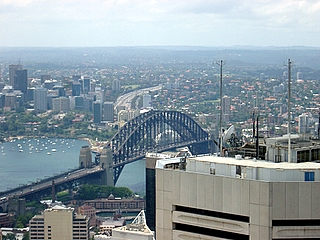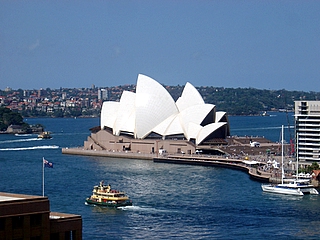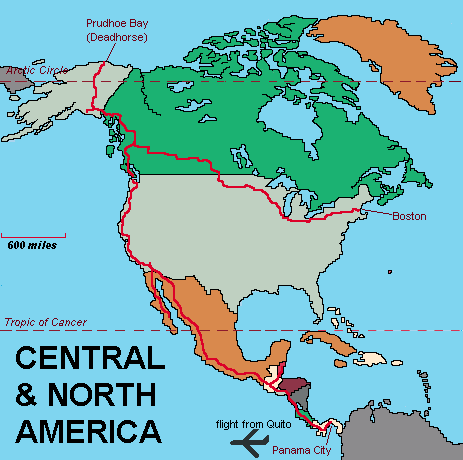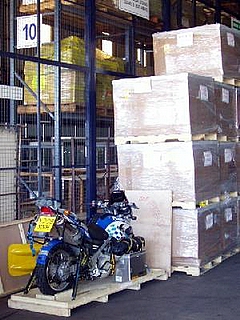It was with a sense of relief rather than rather than
elation or sadness, that I escaped London. First stop was Singapore.
The weather here in Singapore has been horrendous – extremely hot,
around 34 degrees centigrade each day with 100% humidity, but grey and
overcast skies. The newspapers say the overcast weather is as a result
of air pollution from forest fires in Indonesia. I’m not so
sure, maybe it is that but also the amount of exhaust fumes in
Singapore too. It’s not like you can sit by the pool and enjoy the sun.
I was extremely jet lagged and pretty much non functioning for the
first three days – never had jet lag this bad before and could only
manage to grab around four hours sleep each day starting at 6am
Singapore time which was not good at all!
I’ve been here many times before and enjoy
its company. It’s spotlessly clean, technologically advanced
in a way Europe is not – for example, wi-fi hot spots all
over the city, there’s very little crime, you don’t
see gangs of hooded youths hanging around the place, its transport
system is by far and away the best I’ve ever encountered and
there seems to be plenty to do. If you are a shopper, the place is an
absolute delight – shops routinely open until 9pm and
sometimes later. It’s not all built up commercialism, there
are rawer, grittier edges such as Little India, and there are a
surprising number of green places, you just have to seek them out.
There are plenty of coffee shops, and my favourite place to hang out
was the Coffee Bean next to the IT Funan mall, a place to cater for any
type of electronic goods, especially computers. Food is great, with a
wide choice from food courts usually to be found on the top floor of
the shopping malls, or supermarkets, usually in the basements of
shopping malls, street food, food cooked in the open air at hawker
centres, or a wide range of restaurants from the quick and cheap to
real top notch stuff.
Singapore is a tiny place with a lot of people
– around 4.2 million people and 800,000 non residents i.e.
foreigners in 647.5 sq km making it a pretty densely populated country.
The population make up is around 76% Chinese, 15% Malay, 6% Indian.
Languages spoken include English, Malay, Mandarin and Tamil.
Would it be a good place to settle and live and work? I
don’t know. I’ve spoken to many people who have
worked in Singapore; great standard of living – over 92% of
Singaporeans own their own home, and over 91% have a mobile phone,
which incidentally work on the MRT, deep in underground tunnels,
there’s good housing and an excellent (private i.e. paid for)
health care system. It’s very easy to get about, which is
just as well, as owning a car is horrendously expensive and a very
complicated procedure.
Downside, it can get very claustrophobic –
it’s small and samey – and many people say that they leave
the islands at least once a month, just to get away – but at
least it is well placed to hop over to other places. Close by is
Malaysia, just a short drive across the bridge to Johor Bahru.
There’s also Indonesia, many of whose islands can be reached
by ferry from Singapore. Places like mainland Indonesia, Thailand, Hong
Kong, Borneo, Bali are just short plane trips away, which have got to
be a good thing in my book.
Then there’s the single female syndrome. Many
of my friends who know Singapore well have warned me that it is very
hard for expat women to find a partner. The expat men, it seems, are
pursued by local women at every turn (so I’m told) and also
that expat women generally don’t fancy or hook up with local
men. Who knows!
I have to say, the idea of living and working in
Singapore does appeal, perhaps on a short term basis, maybe a couple of
years, but the culture is decidedly different from Europe,
it’s so technologically advanced, safe, clean and ordered.
Maybe too ordered. One of the things I liked about London was its
cultural diversity, not just ethnic diversity, but the different ways
people dressed, the different languages, different ways of living.
I’m not sure I would find that here.
And of course, there’s the issue of finding
work here. It proved quite hard. If you are a foreigner, you need to
have an employment pass EP to be eligible to work. But, you need an
offer of work to get an EP. Hhhmmm. Chicken and egg. Large companies
will sponsor you and I understand that the process of getting an EP
through this route has been much simplified, but even so, you have to
find a willing employer who would see you in the first instance,
without an EP and then be such an outstanding candidate, that they will
employ you. And don’t get me wrong, the standard of education
in Singapore is excellent, and there is a pool of good and well
qualified people in Singapore. So it’s a tricky one, but an
appealing idea to pursue.
~~~~~~~~~~~~
Many people have lived through life defining events.
Some remember where they were and what they were doing when John F
Kennedy died. I’m not old enough for that, but mine first
happened when I was a student preparing breakfast in my bedsit when I
heard on the radio that John Lennon had been shot in December 1980.
But these events get uglier and uglier – the
next event in my psyche being 9/11. My friend Sally in Portugal texted
me to tell me to turn on the TV immediately when I saw the ghastly
replay over and over that has never left me of the planes’
last flights. Then on December 26th the tsunami
hit in SE Asia. I was diving in Sulawesi, Indonesia when the tsunami
hit. I was numb, along with hundreds of thousands of people in
Indonesia and around the world.
On Thursday 7th July, I was in
my room, on line and I received a travel newsflash e-mail that started
to unfold the events of today 7th July 2005: central London has been
rocked by a coordinated and calculated series of terrorist attacks. It
feels surreal. I’m thousands of miles away, a seven hours
time difference, but this, London, is my home, where I live(d). I even
shed a few tears as I watched the BBC World news broadcasts during the
day. Yes, I know I said that I had fallen out of love with London, but
now it seems that this has shown to me that my loyalties still very
much lie in London, with my friends, the place, physically, the streets
I know so well, the buses I complained about, (the number 30 I used to
take, one of which was bombed,) the tubes I griped about. I’m
sure all of our thoughts go out to the people of London and those
injured and killed by the blasts.

 Start in Sydney’s south at the Royal National
Park, the 2nd oldest national park in the world, after Yellowstone. On
Sunday’s you can take the train to Loftus station and then get a tram
right into the park. It’s a short walk from the tram to the visitor’s
centre, where maps and information about trails are provided.
Start in Sydney’s south at the Royal National
Park, the 2nd oldest national park in the world, after Yellowstone. On
Sunday’s you can take the train to Loftus station and then get a tram
right into the park. It’s a short walk from the tram to the visitor’s
centre, where maps and information about trails are provided.  Some trails are challenging, but there is something for everyone and
you can spot many native animals in their natural habitat (just steps
from the visitor’s centre we spotted a Lyre bird, several rainbow
lorikeets and rosellas, white cockatoos as well as the more rare black
variety). It is quite calming listening to all the sounds of the bush
and to know that in one hour you can be back in the city centre and be
shopping in some of the best stores and eating in the best restaurants.
Available too are hire boats to row on the lake, picnic areas and a
place to buy a meat pie, should all that walking make you hungry for
some good Aussie tucker.
Some trails are challenging, but there is something for everyone and
you can spot many native animals in their natural habitat (just steps
from the visitor’s centre we spotted a Lyre bird, several rainbow
lorikeets and rosellas, white cockatoos as well as the more rare black
variety). It is quite calming listening to all the sounds of the bush
and to know that in one hour you can be back in the city centre and be
shopping in some of the best stores and eating in the best restaurants.
Available too are hire boats to row on the lake, picnic areas and a
place to buy a meat pie, should all that walking make you hungry for
some good Aussie tucker.  It’s also good to know the Harbour foreshore and most beaches now have
wonderful walking trails as well. You can walk from Darling Harbour,
around The Rocks and Circular Quay and around to Mrs. Macquarie’s Chair
and Darlinghurst along one trail and take the ferry to Taronga Zoo on
the other side and walk still another trail there.
It’s also good to know the Harbour foreshore and most beaches now have
wonderful walking trails as well. You can walk from Darling Harbour,
around The Rocks and Circular Quay and around to Mrs. Macquarie’s Chair
and Darlinghurst along one trail and take the ferry to Taronga Zoo on
the other side and walk still another trail there.  My name is Greg McKenzie
and I’m currently taking a break from earning a living to do something
which has festered in the back of my mind for a while now – a major
motorcycle trip.
My name is Greg McKenzie
and I’m currently taking a break from earning a living to do something
which has festered in the back of my mind for a while now – a major
motorcycle trip.  I land
in Buenos Aries, Argentina on 21st January 2005,
briefly travelling north to visit Montivideo, Uruguay
before turning south heading for Ushuaia, just short of Cape Horn.
I land
in Buenos Aries, Argentina on 21st January 2005,
briefly travelling north to visit Montivideo, Uruguay
before turning south heading for Ushuaia, just short of Cape Horn.  I intend to visit the Baja peninsula for
some sea-kayaking and more trekking before continuing up into the USA
stopping at Los Angeles and San Francisco on the way.
I intend to visit the Baja peninsula for
some sea-kayaking and more trekking before continuing up into the USA
stopping at Los Angeles and San Francisco on the way.  This morning I swapped the rather average
hotel breakfast for a much better offering from a café on
Plaza del Mayo. Coffee so think it could stand for election. A few
photo´s are attached below to get a flavour of the city. In
truth I´m still seeing the parts of B.A. that some Minister
of Tourism encourages us to see. Despite taking a stroll away from the
tourist / shopping centre today towards the more
´bohemian´ San Telmo barrio this afternoon (lots of
shaded cobbled streets and quaint antique shops) I´m still on
the tourist trail I think.
This morning I swapped the rather average
hotel breakfast for a much better offering from a café on
Plaza del Mayo. Coffee so think it could stand for election. A few
photo´s are attached below to get a flavour of the city. In
truth I´m still seeing the parts of B.A. that some Minister
of Tourism encourages us to see. Despite taking a stroll away from the
tourist / shopping centre today towards the more
´bohemian´ San Telmo barrio this afternoon (lots of
shaded cobbled streets and quaint antique shops) I´m still on
the tourist trail I think.